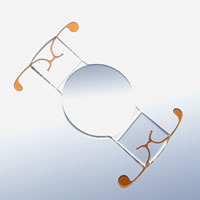Blog 2014-02: Seeing again, after cataracts
- Details
- Last Updated: Sunday, 25 October 2015 23:03
- Written by Dr. Donald H. Mershon

The chemotherapy I received for Hodgins Lymphoma (in 2007) was wonderfully successful in terms of treating the lymphoma, but it did have some side effects. The particular side effect I want to describe here is the influence on my vision. Basically, within a few months, the very mild cataracts that I had had previously were "kicked into high gear.”
After trying various solutions to improve the clarity of my vision, I discovered that I could see pretty clearly, if I wore my standard trifocal glasses – with a second pair of prescription glasses behind them, thus resting “inside” the first. Of course, wearing two sets of glasses at once was not a long term solution. If nothing else, it produced a seriously comical (even bizarre) appearance.
I was lucky in having both some basic knowledge of cataracts and what one can do about them. Summaries of this information can be found in the full articles on Cataracts (Parts 1 and 2) under the header Seeing. I was also fortunate in having already contacted the ophthalmic surgeon whom I wanted to do the job. (I had originally gone to see him, because he was one of the few local surgeons who would handle a type of variable-focus implant known as the CrystaLens®, which I was then considering.) He turned out to be a very patient physician, who was willing to answer the many questions I had and to discuss the comparative benefits and shortcomings of different types of intra-ocular replacement lenses.
Among the factors that I considered relevant for myself were: a) how much advantage would the variability actually give me on a day-to-day basis; b) if an implant involved physical flexing, what was known about its durability (an intra-ocular lens not being the easiest thing to replace, if it broke); and c) how straightforward would it be to replace any of the possible lenses, if they wore out?
Glare was also a concern. Others things being equal, a larger diameter lens should allow relatively less of the incoming light to get around the edge of the lens. Rays that fail to pass through the lens will lack the focusing provided by the lens and will contribute to glare. Glare may be noticed as star-burst streaks from isolated bright sources like a street light or an oncoming car’s headlamps at night, or as just a general haze across the scene. None of these conditions, of course, would contribute to safe driving.
To summarize the situation, at the time I was making a decision, all the approved variable-focus lenses available suffered from one or more shortcomings. All of those I considered were smaller in diameter than a traditional fixed-focus implant, increasing the risk of dysfunctional glare. Those which flexed, in order to achieve their variability, had undergone extensive testing, but not as much as might occur during a possible 10-20 years of use. Worse, it appeared to be more difficult to replace non-traditional lenses, if such were needed. Finally, it did not appear that the benefits of available variable-focus implants would offer more than a modest improvement in actual function
Reference: FDA Panel inquiry into CrystaLens®, at time of its approval).


